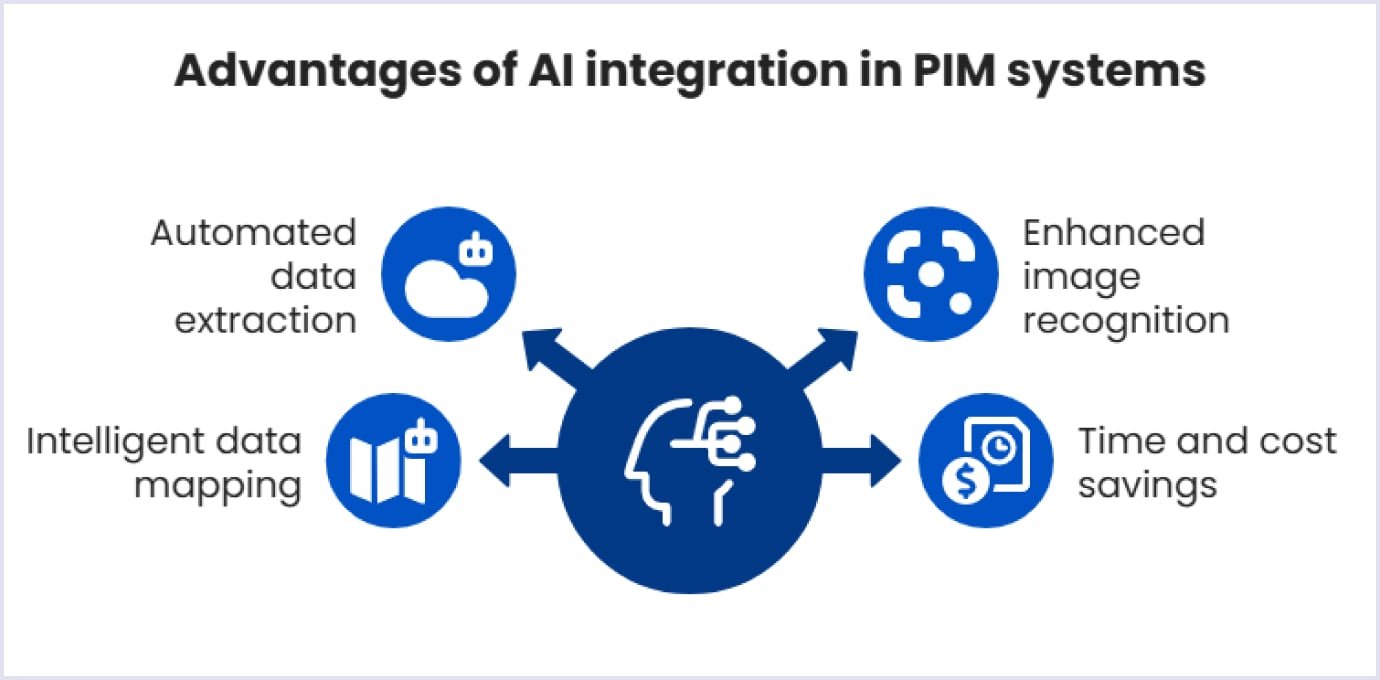On average, Amazon sells 8,600 items a minute. How do they achieve that? It’s their website. Their platform is the point where customers close deals, starting from discovering items and finishing the purchase. Look at their website. It’s not fancy, but it serves the company’s business goals.
One of the crucial parameters is product categorization on the platform. Amazon provides a product taxonomy that guides users through a vast range of categories, right to the point where a customer knows that they found what they needed and is ready to buy.
A convenient product categorization results in a better customer experience and ROI for your business. A PIM system can help. Especially if it is equipped with AI.
We’ve seen firsthand how AI-powered PIM systems work for product categorization and tagging. Thus, our experts provide helpful tips on how to use AI in PIM systems to handle these processes in omnichannel ecommerce.
AI in Product Information Management (PIM) systems
Artificial intelligence is an umbrella term for technologies that replicate human abilities to understand and reason from input information. When a solution is AI-powered, it means that one or several technologies are used to improve the solution’s value and efficiency. In PIM, these AI methods are used for flexible and consistent product information management.
Thanks to the ability to analyze and learn from extensive datasets, AI improves PIM systems in the following aspects:
- Automatic product description generation and translation. AI systems can generate descriptions based on specific attributes stored in a product catalog. These descriptions are generated within seconds and can be nuanced and localized. As a result, AI removes manual workload and increases product teams’ performance.
- Automatic content updates. AI can spot changes in product attributes and update product descriptions. These changes reach all channels at once, preserving data relevance.
- Content and data validation with AI. These processes are possible thanks to AI’s ability to check data consistency. It analyzes data and checks the completeness of product descriptions and specifications.
These AI capabilities are used in product tagging and categorization, making these processes simple and smooth. Let’s discover them in more detail.
Read also: PIM vs. ERP vs. DAM: Understanding the Differences and When to Use Each
Product tagging and categorization in PIM
When organizing products into a coherent taxonomy, we need specific attributes, such as color, size, make, and more. Based on these attributes, we can define product tags and then categorize items using the tags.
Product tagging and categorization are centralized in a PIM system, and any new data reaches the system and relevant channels as soon as they are made. However, without AI technologies, these processes can become overwhelming and tedious.
First off, your team assigns descriptive labels or metadata to products, capturing specific attributes, which is tagging. Then, they organize products in a hierarchy based on the previously formed tags. The process requires a thorough understanding of the product range and meticulous attention to detail to maintain consistency. PIMs centralize processes, but manual workload adds over time and slows down operations.
In this regard, AI is an advantageous tool to relieve your team from the laborious manual management of product tagging and categorization. Let’s see how it works for these processes, respectively.

AI-driven product tagging: enhancing metadata accuracy
The main AI technology used for product tagging is Natural Language Processing (NLP). These models, being a subset of AI, organize chunks of text from product descriptions and customer reviews into smaller parts, such as sentences and words.
They then perform part-of-speech tagging to identify grammatical elements and extract meaningful attributes. These attributes are organized into a structured format, enabling the assignment of relevant tags to each product.
Automatically processed data ensures the accuracy and searchability of products across large product catalogs. Thus, NLP systems are ideal for inventory management in businesses of any scale.

Natural Language Processing (NLP) in tag generation
Regarding the nature of NLP systems, the key steps of automated tag generation in PIM involve the following:
- Data collection and preprocessing. The NLP system gathers data from various sources and then cleans and standardizes it.
- Text analysis and feature extraction. It starts with breaking language units from product descriptions and customer reviews from sentences into words (tokens). Then, NLP performs part-of-speech tagging, identification of grammatical elements, and extraction of meaningful attributes. This step also involves Named Entity Recognition (NER). It means detecting specific entities, such as brand names, product types, or materials within the text.
- Attribute identification. NLP algorithms can discern product attributes based on the context and relationships between words. For instance, in the description of the “comfortable leather sofa,” the system recognizes “leather” as the material and “sofa” as the product type. Moreover, NLP recognizes user sentiment. If the reviews mention “comfortable fit” positively, the system can add the “comfortable” and “good fit” to the product metadata.
- Tag assignment. The extracted attributes are then converted into standardized tags (for instance, “Material: Leather,” “Category: Sofa”) and assigned to the product.
- Continuous learning and refinement. NLP systems use machine learning techniques. As a result, the models adapt to new terminology and changing product descriptions.

AI in automating product categorization
Artificial intelligence significantly advances data collection and processing for product categorization. The technologies used for product categorization involve NLP, ML, and computer vision.
AI in product categorization takes one step further from product tagging and uses advanced ML techniques, thanks to comprehensive training. So, let’s consider this aspect in more detail.
Machine learning techniques for product categorization
AI models for PIM are trained to recognize labeled and unlabeled datasets for different categorization tasks. These types of datasets are used in AI model training and involve supervised and unsupervised learning.
Supervised algorithms are typically more accurate but require labeled data for training. Unsupervised models do not predict predefined outputs but instead detect patterns and groupings. Here are the specifics of each of the groups.

Supervised learning
This type of AI model learning involves training on labeled data, can predict results, and can learn over time. With each example, the model knows what the output is and can recognize data that it has not seen earlier. Common algorithms include:
- Support vector machines (SVM). Effective for high-dimensional data, SVMs find the optimal boundary between categories.
- Random forests. An ensemble of decision trees that improves classification accuracy by reducing overfitting.
- Neural networks. Capable of modeling complex relationships, which is especially useful when combined with deep learning for intricate patterns.
Unsupervised learning
In this training type, AI models learn with unlabeled data and cannot predict results. The models discover hidden patterns without human oversight and predefined categories.
Key techniques include:
- K-means clustering. Partitions products into clusters based on feature similarity, which is useful for discovering natural groupings.
- Hierarchical clustering. Builds a tree of clusters, allowing exploration of data at various granularity levels.
Combined learning
There are also cases when it’s helpful to use both types of learning, which are useful for PIM systems and data processing. For instance, in the case of limited labeled data, you can use it with a large amount of unlabeled data to improve the outcomes. You can also use combined algorithms for complex or noisy data.
Further reading: The Role of Generative AI in Marketplace Development
Benefits of AI integration in PIM systems
Improved data quality and consistency
AI models process extensive datasets and keep changes consistent thanks to structured analysis. The following are the benefits of AI in PIM systems, considering data quality and consistency:
- Automated data extraction and standardization. Advanced AI algorithms make unstructured data from various sources accurate and uniform. This data governance makes further processes of tagging and product categorization error-free and prompt.
- Enhanced image recognition and tagging. Thanks to advanced techniques in identifying attributes, such as color, material, and pattern, AI models help with comprehensive tagging and product classification.
- Intelligent data mapping and classification. AI learns from existing data structures and simplifies the process of mapping and classifying product attributes with automated data.
Time and cost savings
Automated data integration and processing make tagging and product categorization smooth for teams. With AI, teams do not have to manually enter data and analyze every little detail to make product descriptions correct. This automation helps the staff get results quickly, avoid errors, and keep data consistent across different channels.

Challenges and considerations in implementing AI for PIM
Being an advanced technology, AI brings relevant challenges when implemented in PIM. Take them into account when planning your AI implementation into a PIM system:
- Data quality and integration. Organizations may face challenges with fragmented or inconsistent data, which can hinder AI performance. In this case, proper data standardization helps make AI’s work even more efficient.
- System integration and scalability. When dealing with legacy systems, it’s hard to add AI to them. That’s why a PIM system must be robust and scalable to be able to accommodate AI functionalities in full.
- Cost and resource allocation. Developing and deploying AI solutions can be resource-intensive. It is necessary to consider the financial investment for AI tools, infrastructure, and ongoing maintenance. Careful planning and strategic budgeting ensure that AI implementation is sustainable and delivers an ROI.
- Ethical and regulatory considerations. AI data can inadvertently perpetuate biases present in training data. That’s why careful monitoring and mitigating biases in AI models are essential. Also, ensure that your AI models are compliant with data privacy regulations, such as GDPR and laws on responsible AI.
- Training and expertise. Provide training and development programs for your AI professionals who specialize in data science and machine learning, and your staff who use AI in PIM. Thus, you will retain experts who help you make your PIM systems and operations more efficient with AI.
You may also like: AI Pricing: How Much Does AI Cost in 2025?
Case studies: Successful AI Implementations in PIM
Diesel: efficient product tagging
It is a fashion brand known for its luxury products. Diesel had many products styled and photographed and then sent to the team for manual tagging, which consumed significant time and resources. Moreover, the company needed standardized attributes and recognition of “iconic” logos.
Based on their business goals, the team has chosen Vue.ai with computer vision and NLP. The AI-automated product tagging and data synchronization save 30 hours of work per week per person. It also helped the brand to build its own unique taxonomy and trained networks to recognize unique tags.
Read also: How to Create a Fashion Resale Marketplace for Pre-Owned Clothes
Bluestone PIM: helping companies with product enrichment
A construction company has been using outdated systems and turned to Bluestone PIM to get improvements for their business. In particular, they hoped that advanced features, such as AI Enrich, would give them growth and workflow automation.
In fact, this feature has transformed how the company works with product data enrichment. As AI has automated it, the company’s team gained more time to tackle other tasks. As a result of advanced data management, the company reduced time-to-market, saved resources, and improved product experience.

Best practices for adopting AI in product categorization and tagging
There are several aspects you should consider to make these two processes efficient in your PIM with the help of AI. They are as follows:
- Define the business objectives of your AI models for PIM. Outlining your business goals will steer your data preparation and model training in the right direction. So, when you plan to implement AI in your PIM, start with product discovery as a comprehensive analysis of your future technologies.
- Create a robust data foundation. AI models give the best results on high-quality data. Ensure that your product information is accurate, consistent, and well-structured. Standardizing product titles, descriptions, and attributes facilitates AI training and deployment.
- Use advanced machine learning techniques. A combination of supervised and unsupervised learning methods enhances categorization accuracy. This combination brings the benefits of two approaches, resulting in accurate output along with the ability to predict patterns and handle data scalability.
- Incorporate Natural Language Processing (NLP). As NLP analyzes texts with product data, extracts meaningful attributes, and assigns relevant tags, it can help you streamline your operations and deliver better outcomes to your customers.
- Implement active learning strategies. Active learning allows AI models to identify and learn from the most informative data points. AI queries them out of the whole scope of data when human labeling is needed. This makes labeling more efficient and focused, especially when you need to label vast amounts of data.
- Evaluate and improve your models. Continuous evaluation of your AI model is necessary for accurate results. Consider feedback from customers and your teams on the results obtained after AI implementation.

Future trends: AI and the evolution of PIM systems
These technologies have already given positive results by improving data quality across sales and operations channels. The future shift will be toward more intelligent, autonomous, and real-time product tagging and categorization with AI-powered PIM solutions. Here are the prominent technology shifts you can expect in the future:
- Advanced machine learning for intelligent categorization. Sophisticated machine learning algorithms will improve over time and make product tagging and categorization more accurate, depending on shifts in data.
- Emergence of agentic AI in PIM. Agentic AI refers to autonomous AI systems that can make decisions and perform tasks without human supervision. In the context of PIM, agentic AI can proactively manage product data, optimize workflows, and adapt to new information dynamically.
- Continuous learning and adaptation. Modern AI models within PIM systems learn continuously from new data and user interactions. Thus, AI systems refine their algorithms, improve data accuracy, and adapt to evolving business needs and market trends.
As AI and real-time processing evolve, PIM systems will increasingly integrate predictive data analytics. It will inform decisions around product categorization, pricing, and content localization.
To wrap up
PIM systems are great at centralizing data and distributing it across channels. With AI, they become a superpower for product data management. Standardized data, accuracy, sentiment understanding, and queries for human labeling are a few benefits AI brings to PIM. Thanks to advanced algorithms that automate tedious work, teams can focus on more strategic problems.
If you want to build your own PIM system, we are eager to help. Our custom software experience and AI development services will help you get a robust and scalable solution. Contact us to discuss the details of your project and get a free quote.
